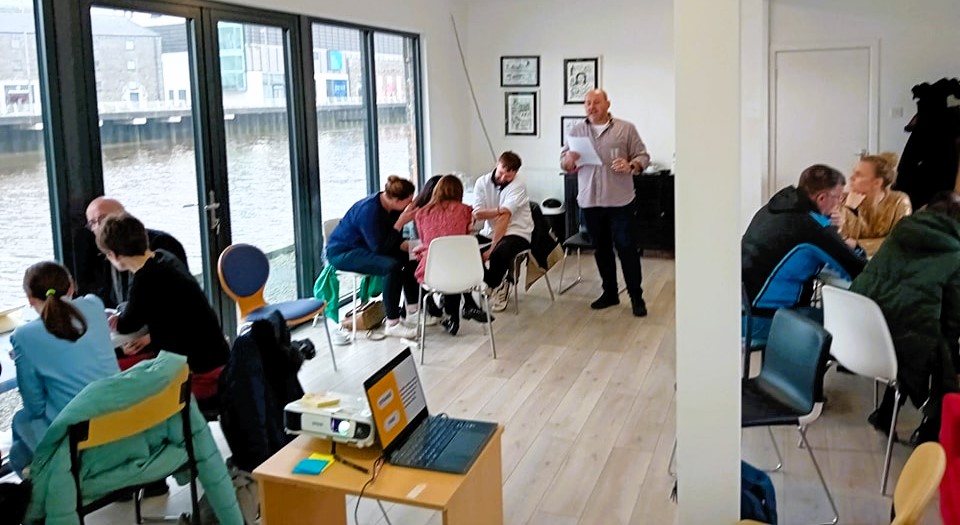Recently I had an opportunity to take part in “Tackling Misinformation Masterclass” organized by Development Perspectives. Though it was just a three-hour long training with Carmine Rodi Falanga, it was a fruitful, productive and informative training for individuals and organisations to tackle disinformation and misinformation in our working environments and our communities. This workshop allowed us to gain new skills and knowledge related to conspiracy theories, and “fake news” through participatory learning and how we can raise awareness of these issues as educators. There were around 15 participants, and I was one of them.
As we are living in a technology era, we cannot avoid the influence of technology in our daily lives. In the past, we disseminated news through telegraphs, posts, newspapers, traditional television and telephones but now we can spread the news just in a second by clicking share on social media through our smartphones. So, it is crucial to know about media literacy.
- First, we discussed the meaning of Disinformation, Misinformation and Mal-information.
- According to UNESCO’s definition, Disinformation is information that is false and deliberately created to harm a person, social group, organization or country such as hoaxes, spear phishing and propaganda. It spreads fear and suspicion among a population.
- Misinformation defines information that is false but not intended to cause harm – rumours, insults and pranks.
- Malinformation is truth used to inflict harm on a person, organisation or country such as online harassment, doxing and revenge porn.
- Conspiracy theories define the belief that events are secretly manipulated behind the scenes by powerful forces with negative intent which often starts as a suspicion. They ask who may benefit from the event or situation and thus identify the conspirators. Any ‘evidence’ is then forced to fit the theory. Conspiracy theories increase in prevalence in periods of widespread anxiety, uncertainty, or hardship, such as during wars, economic depressions and in the aftermath of natural disasters like tsunamis, earthquakes, and pandemics.
To understand these definitions, we did a few exercises to test our media literacy knowledge with “Kahoot!” an online application by answering some multiple-choice questions and discussing the questions and answers. Then, we divided into groups, and discussed some headlines, all of which had been published somewhere at some time, and whether they were true or false.
Even in Ireland, these issues are widely spread. Recently, there has been opposition to the government’s plan to accommodate refugees and asylum seekers in some counties of the country and some far-right groups have taken this opportunity to circulate disinformation and mal-information intentionally which impacts immigrants negatively.
This training made me reflect on the current situation in my country, Burma (Myanmar). Coming from a country where military dictatorship has controlled power for about five decades, people have been brainwashed with government propaganda against the opposition political parties. Under dictatorship, people were living in fear, lost their freedom of expression, and access to factual, accurate and reliable information, and lack of media literacy. Since the 2021 Military coup in Burma (Myanmar) the military-backed government, itself spread misleading or false information intentionally to deceive or manipulate people as a way to advance their interests or discredit their opponents (revolution forces established with civilians after the military coup). The military armies committed human rights violations daily such as burning villages, killing people, and arresting people. The regime always denies these violations through so-called “State Media” channels including printed newspapers, radio and television.
Several years of civil conflicts has hindered the development of the country and left it behind compared to powerhouse neighbouring countries such as Thailand, China, India and ASEAN countries. Not only political instability but also economic insecurity and poverty has led to a higher rate of illiteracy, which has allowed the military regime to manipulate news and information as much as they desired. In addition, after the nominal civilian government was installed in the 2010 General election, people have easy access to affordable mobile sim cards, smartphones and the Internet. At the same time, misinformation, disinformation and mal-information issues are increasing daily.
Without any proper knowledge of media literacy, the circulation of disinformation, misinformation and mal-information is faster and spread within a second through social media platforms including Facebook and TikTok. It is a threat for the communities to spread hate speech, Ethno-religious tensions and fake news. Meanwhile, some independent Burmese media are trying to tackle these issues by designing special programmes about fake news, disinformation and misinformation.
What I have learned from this training is to address the harmful effects of disinformation, misinformation, mal-information, and conspiracy theories, it is essential to advocate for truthful information, endorse media literacy programs, and encourage open and inclusive discussions and mutual understanding among communities through educators and media. Furthermore, policymakers must rely on research that is grounded in evidence, rather than on baseless rumours or prejudices. In conclusion, this training gave me valuable, fruitful and productive information, and I hope to share my experience with my friends and the community around me.


